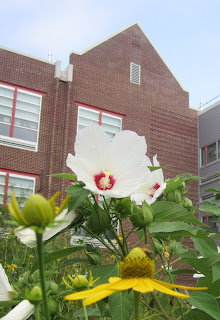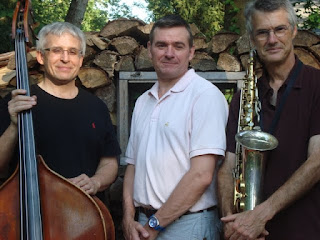Last Tuesday, a third black bear was spotted in Princeton, this time sprawled out front and center in the main meeting room of township hall. Having arrived late, I took awhile to notice the animal, quiet and still as the rest of us while a state wildlife official delivered a powerpoint presentation on bears in New Jersey. No doubt the committee chambers have seen their share of paper tigers, red herrings, fishy development proposals and other forms of political wildlife. On this particular night, however, town officials were safely off at borough hall, hybridizing a new Princeton while township chambers took on a more rustic, camp lodge feel, with the six foot bear skin, its sidekick Skull, and assorted radio collars and other tracking equipment on display.
In a way, the young woman making the presentation, breaking the woodsy stereotype with a fashionable pantsuit and high-heeled clogs, could be seen as presenting an unusual powerpoint eulogy for the bear as it rested in state on the table just behind her.
Here is what I learned, mixed with some info from the states informative
website: Black bears used to range over all of what is now NJ, but were killed indiscriminately until 1953, when they were given some protection under New Jersey's game laws. The hunting season was closed in 1971. Over the past fifteen years, their population has spread from northwest New Jersey until they have now been sighted in every county in NJ. Despite the expansion, funding for bear management has faced deep cuts.
Complaints about bears doubled from 2006 to 2008, but have remained fairly stable since then.
Hunts were allowed in 2010 and 2011 during a five day stretch in December.
In spring, the one and a half year olds head out to seek new territory. Bears are highly territorial, and the young bears much prefer to seek new territories than to risk what can be very violent and debilitating battles with already established bears. Princeton's recent visits by bears are of this nature.
Lots of photos were shown of bear-proof trash cans, and bears climbing up to empty the contents of birdfeeders. Another showed a garage door bent out of shape by bears seeking food. Since any bear that experiences the satisfactions of garbage will seek more of the same, it's important that homeowners in northern Jersey and other areas where bears have become numerous act in concert to keep food out of reach. Some towns have passed ordinances to regulate trash storage.
In the description of what to do if you see a black bear, I was astonished to learn that, in the very rare case that a black bear attacks, the best tactic is to fight back. Princetonians have not been called upon to display such courage since 1777, when we all could conveniently claim we had yet to be born.
To bridge this gap between experience and expectation, I herein provide a translation of the wildlife officials’ instructions, customized to fit the Princetonian lifestyle:
Black bears are near-sighted, so make noise to avoid surprising it. If the bear stands up on its hind legs, don’t worry. It’s just trying to see you better. Make sure the bear has an escape route. For instance, if it is following you out of the public library, hold the door open and give it plenty of room. If you encounter the bear in the woods, or on Nassau Street, you can back away slowly, but don't turn your back to the bear. In a calm, assertive voice, put the bear on notice that you are a Princetonian fully armed with opinions, and will not hesitate to express them.
Avoid eye contact. If it doesn't run away right off, bang the pot you happen to be carrying with you, or download a "kitchenware noise" app on your iphone. Bears hate to cook, which explains their interest in garbage. Otherwise, clap your hands, raise your arms over your head, wave a jacket, all of which should make you look large and impressive.
On rare occasions, the bear will do a bluff charge, at speeds up to 35 mph. If a cafe is close by, this is a good time to duck in for a double latte. If that option is not available, then you'll need to dig deep. Fleeing will only make you appear weak. Perhaps the stirring words of a high school football coach will come to mind. In any case, stand your ground, wave your arms and shout. Pretend you're in front of town council, venting your outrage over moving the Dinky. The bear should veer away from you at the last moment, providing a bigger thrill than any 3D movie at the mall.
If the bear actually attacks, which is extremely rare, it's time to drop all remaining pretense of civility. Fight back. Don't worry about the bear's lack of access to dental care. Without asking permission, bop it on the nose. Bears' noses are 100 times more sensitive than ours. Use this sensitivity to your advantage, all the while reveling in what a great story this will make to tell the grandkids.
In case you surf the internet for more info, don't be confused by accounts of how to behave when encountering a grizzly bear out west, where the protocol is completely different and not nearly so gallant.



























